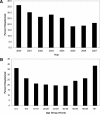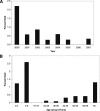Rocky mountain spotted fever in the United States, 2000-2007: interpreting contemporary increases in incidence
- PMID: 20595498
- PMCID: PMC2912596
- DOI: 10.4269/ajtmh.2010.09-0752
Rocky mountain spotted fever in the United States, 2000-2007: interpreting contemporary increases in incidence
Erratum in
- Am J Trop Med Hyg. 2010 Sep;83(3):729-30
Abstract
Rocky Mountain spotted fever (RMSF), a potentially fatal tick-borne infection caused by Rickettsia rickettsii, is considered a notifiable condition in the United States. During 2000 to 2007, the annual reported incidence of RMSF increased from 1.7 to 7 cases per million persons from 2000 to 2007, the highest rate ever recorded. American Indians had a significantly higher incidence than other race groups. Children 5-9 years of age appeared at highest risk for fatal outcome. Enzyme-linked immunosorbent assays became more widely available beginning in 2004 and were used to diagnose 38% of cases during 2005-2007. The proportion of cases classified as confirmed RMSF decreased from 15% in 2000 to 4% in 2007. Concomitantly, case fatality decreased from 2.2% to 0.3%. The decreasing proportion of confirmed cases and cases with fatal outcome suggests that changes in diagnostic and surveillance practices may be influencing the observed increase in reported incidence rates.
Figures








References
-
- Helmick CG, Bernard KW, D'Angelo LJ. Rocky Mountain spotted fever: clinical, laboratory, and epidemiological features of 262 cases. J Infect Dis. 1984;150:480–488. - PubMed
-
- Dantas-Torres F. Rocky Mountain spotted fever. Lancet Infect Dis. 2007;7:724–732. - PubMed
-
- Wilson LB, Chowning WM. Studies in pyroplasmosis hominis (“spotted fever” or “tick fever” of the Rocky Mountains. J Infect Dis. 1904;1:31–57. - PubMed
-
- Rucker WC. Rocky Mountain spotted fever. Public Health Rep. 1912;27:1465–1482.
-
- Dalton MJ, Clarke MJ, Holman RC, Krebs JW, Fishbein DB, Olson JG, Childs JE. National surveillance for Rocky Mountain spotted fever, 1981–1992: epidemiologic summary and evaluation of risk factors for fatal outcome. Am J Trop Med Hyg. 1995;52:405–413. - PubMed
MeSH terms
LinkOut - more resources
Full Text Sources

